More than 240 people have been injured by the typhoon, which brought winds of up to 203 km/h (126 mph) and is Asia’s most powerful storm so far this year.
Ten cars and two scooters fell into the Red River following the collapse of the Phong Chau bridge, Deputy Prime Minister Ho Duc Phoc said.
The moment a lorry plummeted into the water as the bridge decking ahead fell away before the driver had time to stop was captured on camera.
At least three people have been rescued from the river so far.
Part of the 375-metre (1230 feet) structure is still standing, and the military has been instructed to build a pontoon bridge across the gap as soon as possible.
At least 44 people have been killed in landslides and flash floods, Vietnam’s ministry of agriculture and rural development said on Monday.
Among them were a 68-year-old woman, a one-year-old boy, and a newborn baby.
The typhoon also tore roofs from buildings and uprooted trees.

Yagi, Asia’s most powerful storm this year, has killed at least 59 people since it made landfall in Vietnam on Saturday
In the Yen Bai province, flood waters reached a metre (three feet) high on Monday, with 2,400 families having to be evacuated to higher ground as levels rose, AFP news agency reported.
Nearly 50,000 people were evacuated from coastal towns in Vietnam, with authorities issuing a warning to remain indoors.
Schools were temporarily closed in 12 northern provinces, including Hanoi.
Before hitting Vietnam, Yagi left 24 people dead across southern China and the Philippines.
As the world warms, typhoons can bring higher wind speeds and more intense rainfall, although the influence of climate change on individual storms is complicated.
SOURCE: BBC

 6 months ago
44
6 months ago
44

 English (US) ·
English (US) ·